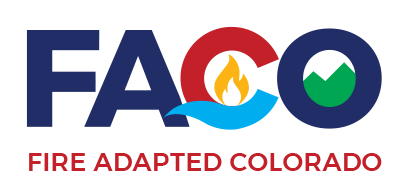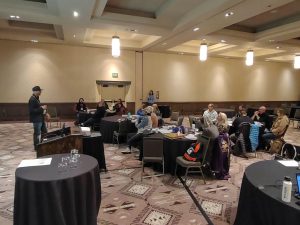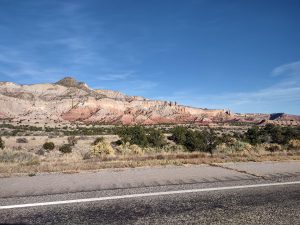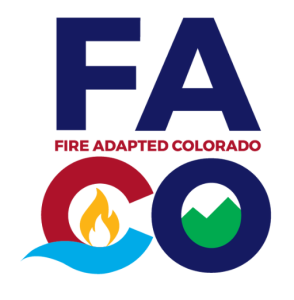Insights and Inspirations
Themes from the Cohesive Wildland Fire Management Workshop in Santa Fe, NM
Rebecca Samulski, Executive Director Fire Adapted Colorado
The 6th annual National Cohesive Wildland Fire Management Workshop took place in Santa Fe, NM, in November, drawing over 300 participants from across North America. Notably, 27 of Colorado’s wildfire resilience leaders from organizations such as Boulder County Fireshed Collaborative, Coalitions & Collaboratives Inc., and the Wildfire Research Center actively contributed to the event’s success. Engaging in workshops, sessions, panels, and poster presentations, these representatives effectively showcased Colorado’s leading role in advancing wildfire resilience efforts. “Despite Colorado’s reputation as a leader in wildfire resiliency, it’s crucial for all of us to recognize that there’s still a lot we can learn collectively,” said Jonathan Bruno, CEO of Coalitions and Collaboratives Inc.
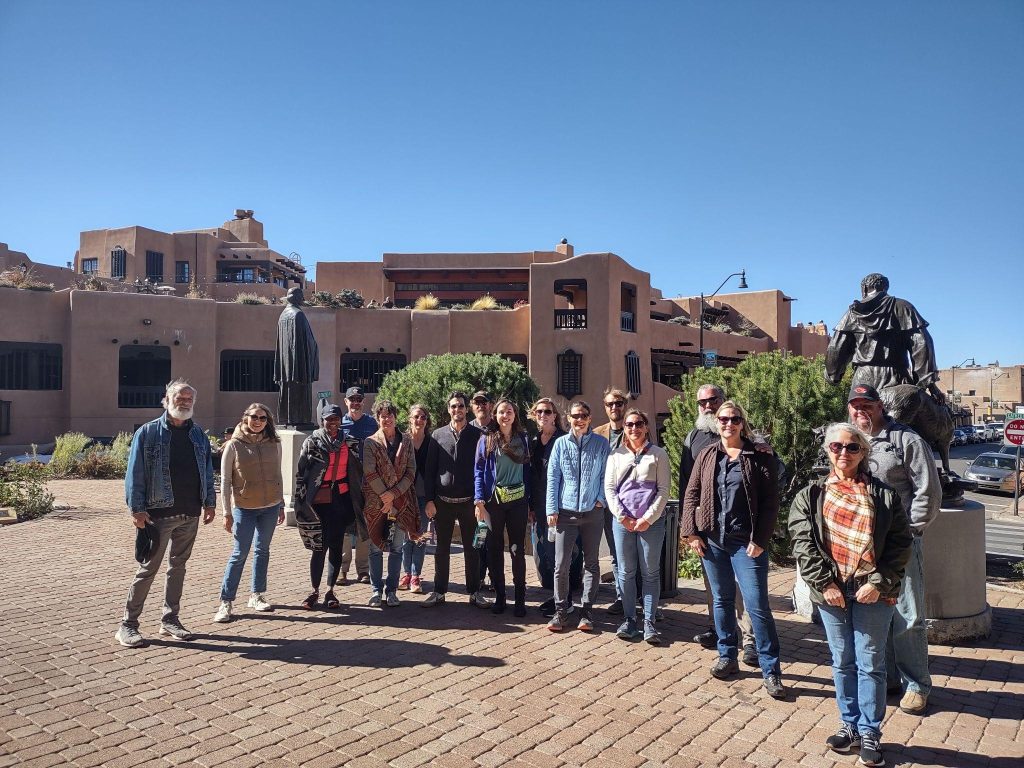
Cohesive Strategy workshop participants on a historic tour of downtown Santa Fe. Those who could afford to spend all day on tour got priceless experiences of the Santa Fe Municipal Watershed and Hyde Memorial State Park.
Networking and Knowledge Exchange
Networking and knowledge exchange were integral aspects of the workshop, with participants expressing enthusiasm for building connections and exchanging ideas.
Rebecca Samulski, Fire Adapted Colorado’s Executive Director, attended the workshop to: help facilitate the 2-day pre-conference Community Wildfire Mitigation Best Practices course with Coalitions & Collaboratives; share and expand adoption of the FAC Neighborhood Ambassador Approach with Wildfire Adapted Partnership; and reconnect with old friends and build new professional connections and friendships. “I returned home with amazing new connections from GA, to CA and AK and inspired ideas to keep making progress on how we can better live with fire in our state.”
- Coalitions & Collaborative’s Mitch Dahlke leads Community Wildfire Mitigation Best Practices workshop activities during the 2-day pre-workshop training.
- St. Francis of Assisi, patron Saint of Animals, watches over the Santa Fe plaza area
- The beautiful drive from Colorado to Santa Fe was an additional draw for those Colorado participants who drove to Santa Fe for the 6th annual Cohesive Strategy workshop.
Gloria Edwards, Director of the Southern Rockies Fire Science Network, attended to learn the latest in regional wildland and prescribed fire issues, advance regional science, plan upcoming knowledge exchange events with the Joint Fire Science Program and state partners, and expand their outreach methods including videos and haikus! “I came back re-invigorated in my efforts to stay up-to-date and “think outside the box” in providing knowledge exchange for our SoRock users!”
Tyler Beeton with the Colorado Forest Restoration Institute attended the National Cohesive Wildland Fire Management Strategy Workshop for his first time. There to discuss the integration of Potential Operational delineations and Community Wildfire Protection Plans, Tyler also built new partnerships to support applied research and practice. “I made new connections across the United States, and I came home excited to continue our work at the Colorado Forest Restoration Institute to support our partners in developing and applying locally, relevant science and information to inform forest and fire management decisions.” Josh Kuehn, who recently joined the Wildfire Research Center as a Mitigation Specialist, also saw the workshop as a platform for meaningful exchanges with passionate practitioners. “I am excited to bring home a host of new connections with thoughtful passionate wildfire practitioners along with some ideas about how WiRē can nestle itself within the cohesive strategy.”
Diverse Perspectives and Cohesive Strategy Lessons from other Lands
Diversity of perspectives was a standout feature, according to Jonathan Bruno of Coalitions & Collaboratives Inc. The workshop’s ability to attract a diverse range of participants allowed for engaging discussions that spanned various viewpoints. “Despite Colorado’s reputation as a leader in wildfire resiliency, it’s crucial for all of us to recognize that there’s still a lot we can learn collectively.” Esther Duke, also of COCO, was enthusiastic about connecting with several colleagues undertaking amazing work within their tribal communities and building partnerships between tribes.
Paul Orbuch of the Boulder County Fireshed Collaborative expressed curiosity about learning from different regions, citing New Mexico’s adaptation strategies post-Hermit’s Peak/Calf Canyon, amid a lack of public trust and Oregon’s ‘debacle’ creating a state-wide wildfire risk map. For Paul, the workshop “reaffim[ed]… the value of the Cohesive Strategy and structuring our efforts in Colorado around those principles.”
Janae Coston-Malpas, Colorado State Forest Service’s NE Area Wildfire Resilience Coordinator appreciated the rich learning about wildfire resilience strategies. “I’m grateful for the opportunity to have learned more about what steps other states are taking in moving towards a more cohesive strategy and more importantly, was able to connect with others in similar roles to hear more about how their position is helping to support these efforts.”
“I appreciated the opportunity to learn from other attendees from different regions of North America about how they are working to innovate and expand their strategies to address local issues and challenges related to wildfire.” – Todd Loubsky, Colorado State Forest Service SW area Wildfire Resilience Coordinator
Kenzie Hartt, The Ember Alliance, attended the workshop to teach part of the Leading the CWPP Process course and stayed to learn about wildfire mitigation and resilience from places outside of Colorado and the US West. “I returned with connections from not just across the US, but also from across Canada!
Community engagement and grassroots efforts took center stage, with participants like Ashley Downing from Wildfire Adapted Partnership, who attended to present with FACO on the FAC Neighborhood Ambassador Approach, reflecting, “I was impressed with the enthusiasm of many participants to use this approach to support and build upon the work they are already doing in their areas.”
Don and Toni Moore of the NoFloCo Fire Mitigation Posse attended the full workshop as well as the Community Wildfire Mitigation Best Practices pre-conference workshop and shared their experience as private property owners, emphasizing the importance of community involvement in restoring forests. “Attending the Wildland Fire Cohesive Strategy in Santa Fe allowed me to meet the people who have been mentoring NoFloCo for the past three years,” says Toni. “The blog posts, emails, and workshops we have followed are led by the people we met and interacted with at the Workshop. It was rewarding and exciting to see the bigger vision of what can be accomplished when citizens, community organizations, municipalities, districts, tribes, and government agencies all pull in the same direction, with the same language, goals, and plans to correct generations of suppression on wildfire ecology and mitigation.”
Other Learning Moments
Patty Champ from USDA Forest Service Rocky Mountain Research Station reflected on the Santa Fe Watershed tour, emphasizing the value of a “landscape of collaboration” and the significance of working together over time with a shared mission.
“I’m excited to bring back a fresh perspective on CWPPs and how PODs can be tiered to them to leverage both tools to protect communities. I got to interact with a bunch of new people who work on CWPPs, and I’m looking forward to interacting with them more and learning more from them!” – Ty Aldworth, Colorado Forest Restoration Institute
Additional Words of Wisdom collected by Colorado Wildfire Resilience Leaders
Alex Handloff with Mountain Studies Institute went to the conference to learn more about what Cohesive Strategy means and present on behalf of the 2-3-2 to a broader audience. He was struck by how hard it was for anyone to come up with three simple things to tell the general public about wildfire and is motivated as a communication expert to work on this challenge. A quote from Coalitions and Collaboratives’ presentation resonated with Alex, “Mitigation is the emergency, not once the fire starts.”
A mentality portrayed in the Coalitions and Collaboratives presentation also resonated with Chazz Lakin with the Colorado State Forest Service as a way to resolve isolated capacity issues. “Collaboration and sharing of resources between adjacent communities should be so frequent that equipment is virtually always in use and never sitting around, collecting dust.”
Kenzie Hartt shared a favorite quote that she heard and promises to use a lot moving forward is ‘if we aren’t prepared for prescribed fire, we aren’t prepared for wildfire.’” FACO’s own Executive Director, Rebecca Samulski shared this quote, admittedly looking for the original source. If anyone knows who first said this, please let us know.
The Cohesive Wildland Fire Management Workshop served as a testament to the power of collaboration, networking, and knowledge exchange, the more diverse, the better. While these posts represent a small fraction of reflections from some of our Colorado wildfire resilience leaders who attended, the collective commitment to addressing wildfire resilience was evident. The shared experiences and insights gathered will undoubtedly contribute to ongoing efforts in Colorado “to safely and effectively extinguish fire, when needed; use fire where allowable; manage our natural resources; and collectively, learn to live with wildland fire. (National Cohesive Wildland Fire Management Strategy Vision, 2023 Addendum)”
